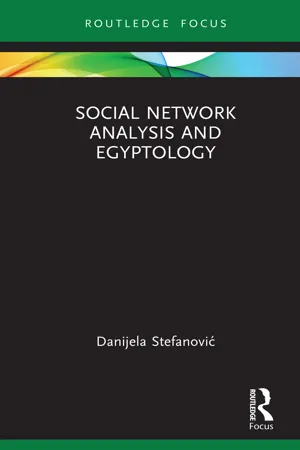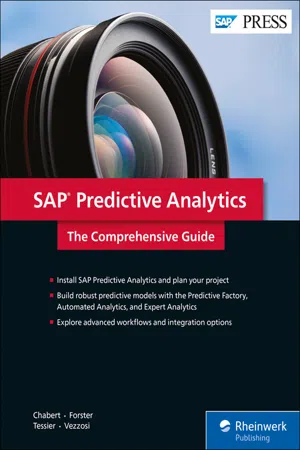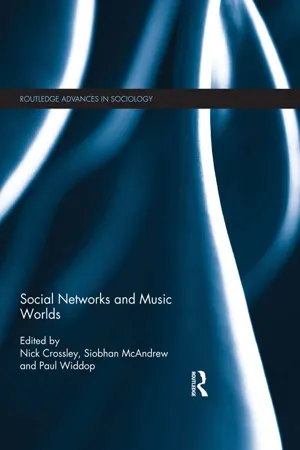Business
Social Network Analysis
Social Network Analysis is a method used to analyze relationships and interactions within a network. In a business context, it can be used to understand how individuals or groups are connected, identify key influencers, and uncover communication patterns. By visualizing and analyzing these networks, businesses can gain insights into collaboration, information flow, and decision-making processes.
Written by Perlego with AI-assistance
Related key terms
Related key terms
1 of 4
Related key terms
1 of 3
10 Key excerpts on "Social Network Analysis"
- Chiara Tagliaro, Marko Orel, Ying Hua, Chiara Tagliaro, Marko Orel, Ying Hua(Authors)
- 2023(Publication Date)
- Routledge(Publisher)
10 Social Network Analysis Studying social interactions and relations in the workplace Yaoyi Zhou Virginia Tech, USADOI: 10.1201/9781003289845-10This chapter has been made available under a CC-BY-NC-ND 4.0 license.10.1 Background
Social networks are defined as a set of nodes (or network members) that are tied by one or more types of relations (Wasserman & Faust, 1994 ). For those not familiar with network research, a network is a set of actors connected by a set of ties. The actors (often called “nodes”) can be persons, teams, organizations, concepts, etc. Ties connect pairs of actors and can be directed (i.e., send a message to someone) or undirected (as in being physically proximate) or valued (i.e., strong vs. weak friendship). A set of ties of a given type (such as friendship ties) constitutes a binary social relation, and each relation defines a different network (e.g., the friendship network is distinct from the advice network). Different kinds of ties are typically assumed to function differently, although empirically they might be correlated. Some typical phenomena such as small-world effect (Pool & Kochen, 1978 ), the strength of weak ties (Granovetter, 1983 ), and many others may be observed in social networks.Social Network Analysis (SNA) is a research methodology that seeks to identify underlying patterns of social relations based on the way actors are connected with each other (Breiger, 2004 ; Scott & Carrington, 2011 ). The unit of analysis in SNA is not the individual, but the relationships or interactions that occur between members of the network. Using SNA, the social environment can be mapped as patterns of relationships among interacting members.When applying a network perspective, SNA can be used to indicate how a certain individual is connected to others, and also indicates the cohesion of a network. There are two key indicators used in SNA: “density” and “centrality.” Density provides a measure of the overall “connections” between the participants. The more participants connected to one another (by, for example, their message exchanges), the higher will be the density value of the network. While centrality indicates the extent to which an individual was connected to other actors within a network (Wasserman & Faust, 1994- eBook - ePub
- Danijela Stefanovi?(Author)
- 2024(Publication Date)
- Routledge(Publisher)
2 Social Network Analysis – a brief overview
DOI: 10.4324/9781003457015-2Social Network Analysis (SNA) is a method developed in the mid-XX century in mathematics, anthropology, and sociology, and is used to describe, analyse, and measure human relations.1 However, its roots can be traced back to the end of the XIX century and research on social structures and social links by Émile Durkheim and Ferdinand Tönnies.2 The works of Jacob Moreno, William Lloyd Warner, and Elton Mayo, as well as of Alfred Radcliffe-Brown, exemplifying the three leading traditions in network studies, marked the early decades of the XX century.3Jacob Moreno is particularly important among these scholars. Along with Helen Hall Jennings he developed sociometry, a technique obtained by applying quantitative methods that inquire into the development and organisation of individual groups and the position of single actors within them.4 His major achievement was the invention of a sociogram as a way to represent the formal properties of social configurations. The sociogram has become one of the most powerful innovations in network analysis, because it enables the visualisation of social networks.With Alfred Radcliffe-Brown’s stress on the concept of ‘social structure,’ and the idea that social actions were organised, studies of social networks came to the fore.5 In the 1960s and the 1970s, a significant number of researchers worked on the implementation of various theories and concepts for the study of social interactions and connections, leading to Social Network Analysis. For example, Stanley Milgram developed the concept of ‘six degrees of separation,’ and Mark Granovetter elaborated on the theory of the ‘strength of weak ties’ within the network.6 Since then, the body of research on Social Network Analysis has grown significantly, and academic journals, textbooks, vocabulary, and an increasing sophistication in its technical tools have been developed.7 - eBook - ePub
SAP Predictive Analytics
The Comprehensive Guide
- Antoine Chabert, Andreas Forster, Laurent Tessier, Pierpaolo Vezzosi(Authors)
- 2017(Publication Date)
- SAP PRESS(Publisher)
12 Social Network Analysis
Social Network Analysis lets you analyze the relationships between people, products, locations, and events—not just analyzing social networks as its name might suggest. You can work with a large number of small interactions and infer the “big picture” to help better understand your business.Social Network Analysis is one of the latest modules added to SAP Predictive Analytics. Initially, the functionality was included to help phone companies predict customer churn and run better marketing campaigns, but the solution has been generalized to benefit other industries as well. For example, a quality engineer could receive alerts generated by devices and analyze which errors are linked. You can also use Social Network Analysis to enrich a dataset with information that can then be fed into a classification, clustering, or regression model to increase its quality.In Social Network Analysis, you’ll analyze sets of data about entities as in other predictive analytics workflows; the main difference is that the most important information in Social Network Analysis is the relationship between entities. Other attributes are useful but not the core of the analysis.For example, when looking at three customers, in most analysis workflows, you would look for their ages, their genders, and their incomes. In Social Network Analysis, you instead look at how they interact with each other—how each potential customer has contacted one another. From that analysis, perhaps you would find stronger relationships between certain persons and that some individuals could, for example, influence other people in the social network.SAP Predictive Analytics also lets you analyze indirect relationships, such as when people often purchase similar products, called a transactional relationship . With transactional relationships, even if no direct link exists between customer X and customer Y, you could use customer X’s information to recommend to customer Y a new product that had just been purchased by customer X, if the two customers have similar purchase patterns. This kind of analysis is described in Chapter 13 - eBook - ePub
- Nick Crossley, Siobhan McAndrew, Paul Widdop, Nick Crossley, Siobhan McAndrew, Paul Widdop(Authors)
- 2014(Publication Date)
- Routledge(Publisher)
2 What is Social Network Analysis? An introduction for music scholars Nick Crossley, Siobhan McAndrew and Paul WiddopIn this chapter we offer a brief introduction to the fundamental concepts and techniques of Social Network Analysis (SNA) used by most of the contributors to this book. Our primary aim is to provide readers who are unfamiliar with SNA with the necessary background knowledge to fully engage with the book. Those who wish to go further and use SNA in their own research will need to read more widely. However, we hope that the book will inspire music and culture scholars to consider using SNA and to this end we extend our remit slightly by both discussing some of the questions that SNA allows us to address and briefly introducing some of the main software packages that network analysts typically use: e.g. UCINET,1 Pajek,2 PNet3 and Siena.4Readers who wish to learn further about SNA should consult one of the excellent textbooks in the area. We briefly review our preferred teaching texts at the end of the chapter. Networks and network analysisAs we noted in the Introduction to this book, ‘musicking’ is collective action. It involves connection and interaction between social actors. On a very basic level, for example, individual musicians interact both with one another, with a variety of support personnel, such as promoters, managers and studio engineers, who also interact with one another, and with audiences, who again also interact with one another and with support personnel. In addition, connections exist on other levels: works borrow from other works, the organisations involved in the music industry interlock in different ways and venues, cities, festivals and countries are all linked by the flow of artists and works between them. - eBook - ePub
- David Inglis, Anna-Mari Almila, David Inglis, Anna-Mari Almila(Authors)
- 2016(Publication Date)
- SAGE Publications Ltd(Publisher)
Whether we conceptualise it in the narrow sense of ‘art’ and specific ‘art worlds’ (Becker, 1982) or the wider sense of everyday practices and beliefs, culture entails social networks. Everyday cultures are, by definition, shared, and they are shared because they diffuse outwards from a point of origin (itself often a network), through network channels. We speak the language that we do, with the accent that we have, for example, because of our extensive contact with others who do the same. Languages and accents ‘travel’ through the paths created by interaction. Similarly, the emergence of new and the reproduction of existing art worlds requires a connected critical mass of participants who, because networked, are able to combine their resources and coordinate their activities, jointly performing the various roles required for the (re)production of their art and drawing upon the social capital and related emergent phenomena that specific patterns of connection facilitate (Crossley, 2015a). Beyond individual human actors, moreover, cultural organisations and institutions are connected, and individual cultural units, from words in semantic networks to stylistic markers within artistic schools, each manifest patterns of connection, that is, networks, which are central to their identity and existence. Furthermore, as DiMaggio (1987; 2011) argues, cultural works and artists often become associated, seeming to form a distinct school or style, where they have ties to a common audience: ‘Just as populations of persons can be partitioned into groups on the basis of the works of art they like, so populations of art works can be partitioned into groups, or genres, on the basis of the persons who choose them’ (DiMaggio, 1987: 445). The connections of audiences to artists and works define styles, much as styles define audiences (e.g. as subcultures), in complex ‘two-mode’ networks (see below).Standard sociological methods, albeit with some tweaking, are usually able to gather data on such networks. Analysis of a network requires a systematic survey of relations, as defined by the researcher, between the members of a specified population of nodes, whether human individuals, texts, organisations, bands, studios, venues, cities, nation states or whatever; but this survey can be conducted in any of a number of ways, including many standard sociological methods of data gathering: e.g. questionnaires, semi-structured interviews, direct observation (participant or non-participant), content analysis, archival analysis or automated net trawls. However, the mainstream social scientific repertoire lacks means of storing and analysing such data in a way which captures the structures (of connection) they involve. This is where social network analysis (SNA) comes in.A relatively obscure method until recently, SNA is a method for handling, storing and analysing relational data; that is, data regarding connections between various members of a given population of objects (‘nodes'). Its origins go back to the 1930s and its development has been truly interdisciplinary, involving sociologists, anthropologists, social psychologists and more recently economists (Scott, 2000). Crucially, however, it has also involved mathematicians, in particular specialists in the field of graph theory. Unlike the graphs most of us are familiar with (e.g. bar charts) the graphs of graph theory comprise a set of objects (‘vertices') and a set of links (‘edges’ or ‘arcs') between certain of those vertices. A graph, in other words, is a network, and graph theory is a branch of mathematics devoted to identifying, measuring and analysing the properties of these networks. Not all of this is relevant to social scientific interest in social networks but much of it is and the development of SNA has involved a dialogue between social scientists and graph theorists seeking out their common interests. This is particularly evident in the vocabulary of SNA, which borrows extensively from graph theory. - Travis C. Pratt(Author)
- 2014(Publication Date)
- Routledge(Publisher)
An Overview of Social Network AnalysisJean Marie McGloin and David S. Kirk
IntroductionSocial Network Analysis refers both to a view that social relations provide crucial insight to human behavior and to a set of analytic tools that enable the study of these social relations. Both practitioners and theorists interested in crime can gain important knowledge from a focus on social networks, as the growing literature in criminology demonstrates. This article provides an introduction for scholars interested in becoming better versed in the concepts of basic social network concepts and techniques, as well as a discussion about the conditions under which this form of analysis may be particularly useful.Social Network Analysis is an orientation towards the understanding of human behavior that focuses on the importance of social relations. It is also a set of tools that enable the investigation of social relations and their consequence. The underlying basis of Social Network Analysis is that individuals are interdependent, and these interdependences have consequences for behavior. In contrast, social scientists have traditionally conceived of individuals as independent units, and have limited their focus to the role of actor attributes and norms as explanatory variables of behavior.Theoretically, there are numerous reasons to draw upon core social network concepts to explain the etiology of criminal behavior. Warr (2002, p. 3) argues that, “criminal conduct is predominantly social behavior. Most offenders are imbedded in a network of friends who also break the law, and the single strongest predictor of criminal behavior known to criminologists is the number of delinquent friends an individual has.” Consistent with this view, several seminal works in criminology highlight the group nature of delinquency, showing that the average delinquent committed his acts while in the company of accomplices (Cloward and Ohlin 1960; Cohen 1955; Shaw and McKay [1942]1969; Short and Strodtbeck 1965). This observation is echoed in Sutherland’s (1947) differential association theory, which posits that criminal behavior is learned through social interaction in intimate groups.- eBook - ePub
- Peter Halfpenny, Rob Procter, Peter Halfpenny, Rob Procter(Authors)
- 2015(Publication Date)
- SAGE Publications Ltd(Publisher)
10 Social Network AnalysisRobert Ackland Jonathan J. H. Zhu10.1 Introduction
The last decade has witnessed a surge in research into social networks using trace data collected from the Web. While sociologists have been studying social networks for decades, the interest in researching social networks from other disciplines (e.g., other parts of the social sciences, applied physics, computer science) has arguably been triggered by the availability of data on social interactions in social network sites such as Facebook and information sharing environments such as newsgroups, blogs, and micro-blogs (e.g., Twitter).Figure 10.1 A semantic network of top hashtags from Twitter(www.nodexlgraphgallery.org/Pages/Graph.aspx?graphID=31160)This chapter begins with an introduction to social networks analysis (SNA), outlining the major concepts and how the ‘network perspective’ differs from other social scientific approaches to studying human behaviour. We then provide examples of network research using trace data, highlighting some of the methodological approaches and tools that are available for this type of research. We continue by discussing the challenges and opportunities for network research using trace data. We conclude with some recommendations for researchers who are thinking about using network analysis on how to make best use of the method.10.2 Networks and the Relational Perspective for Studying Behaviour
This section provides a brief introduction to network terminology and concepts, and introduces the network or relational perspective for studying behaviour.Figure 10.2 A directed and outdegree-weighted network10.2.1 Network Terminology
A network is a set of nodes (vertices or entities) and a set of ties (edges or links) indicating connections or relations between the nodes.1 In a social network, the network nodes are typically people and the network ties are relations between people. However, Social Network Analysis is also used to study the behaviour of organizations and groups. A visual representation of a social network is called a sociogram, often informally referred to as a network map (see Figure 10.2 - eBook - ePub
Food Systems Modelling
Tools for Assessing Sustainability in Food and Agriculture
- Christian J. Peters, Dawn D. Thilmany(Authors)
- 2022(Publication Date)
- Academic Press(Publisher)
Other studies utilize mixed methods sequentially, such as beginning with a network analysis and conducting qualitative interviews to investigate underlying influences that impact network connectivity (Luxton and Sbicca, 2021 ; Rocker, 2019). Some researchers have expressed the suggestion that SNA and Input-Output analysis could be seen as complementary methods, articulating multiple levels and dimensions of food systems phenomena from the economic sector level to the individuals, organizations and businesses (Goldenberg and Meter, 2019 ; Trivette, 2019). Future opportunities for multi-level systems research could be approached by interdisciplinary research teams to more deeply explore connections between sector-level economic data with individual and organizational level relational dynamics, as well as subjective accounts of particular practices and activities. 11.7 Conclusion In this chapter, we have explained foundational concepts and methodological approaches in Social Network Analysis, with particular attention to contexts in which SNA has been applied in existing food systems research. Throughout we have sought to offer ideas and open pathways for possible future uses of SNA in food systems research. We have identified some common characteristics of food systems research that has integrated SNA to date and we have highlighted the common patterns found in these early studies, as well as gaps and opportunities for ways that SNA could be integrated in future research design. We have also identified several possible research design ideas, as well as instruments and tools for data collection, analysis and visualization. Food systems studies at their core address the complex interactions of both coordination and contestation among people and resources through production, trade, and consumption as mediated by diverse influences including policy, funding, cultural and social practices, institutional structures, and much more - eBook - ePub
Evolution of Innovation Management
Trends in an International Context
- A. Brem, E. Viardot, A. Brem, E. Viardot(Authors)
- 2013(Publication Date)
- Palgrave Macmillan(Publisher)
Social Network Analysis methods have developed over the past 50 years as an integral part of advances in social theory, empirical research, and formal mathematics and statistics (Wasserman & Faust 1994). The majority of network analysis studies use either whole network or egocentric designs. Whole-network studies examine sets of interrelated objects or actors. Egocentric studies focus on a focal actor or object and his (or its) relationship to his (its) locality within the social network (Marsden 2005).There are a variety of ways in which network data can be gathered, e.g., questionnaires, interviews observations, and experiments. There are also a variety of methods and tools for Social Network Analysis. Social Network Analysis software facilitates quantitative or qualitative analysis of social networks by describing features of a network, either through numerical or visual representation. An overview of software for Social Network Analysis is provided by Huisman and van Duijn (2005). Some of the most common software tools are, for example:• UCINET (http://www.analytictech.com/ucinet/ )• igraph (http://igraph.sourceforge.net/ )• Pajek (http://vlado.fmf.uni-lj.si/pub/networks/pajek/ )One-mode network analyses involve measurements on a single set of actors, and their relations are usually viewed as representing relational contents of many different types. Two-mode network analysis involves measurements on two sets of actors, or on a set of actors and a set of events. The latter represents an affiliation network, which arises when one set of actors is measured with respect to attendance at a set of events or activities (Wasserman & Faust 1994).Networks depicted in this chapter are visualized by the use of Pajek, freeware provided by the University of Ljubljana. 3 Social networks and idea generationCreativity is the ability to produce work that is both novel and appropriate (Sternberg & Lubart 1996). Recent findings have shown that creativity is not only limited to individuals, but that it is also a social phenomenon. By interacting and communicating with others, individuals get access to novel perspectives and unique knowledge, and they can get support for their ideas (Perry-Smith and Shalley 2003; Hargadon and Bechky 2006). Support from a network of social relationships can contribute to a person’s creativity (Madjar et al. 2002) and can facilitate the creation and implementation of creative ideas (Axtell et al. 2000). Previous studies in this area have focused on the effect of network structure on creativity and innovation. Perry-Smith (2006) showed that research scientists with many weak ties were rated as more creative than those with few weak ties, and Obstfeld (2005) stated that engineers with dense social networks were more engaged in developing new products or processes. These studies examined the relationship of network structure and creativity, but research has generally neglected the antecedents of network structure (Brass et al. 2004). - eBook - ePub
- Carlos Andre Reis Pinheiro(Author)
- 2011(Publication Date)
- Wiley(Publisher)
It is also possible to observe how fast a particular business event can spread inside the network or subnetwork as well as the direction of that flow in terms of geographic localities. Is a churning event heading to some particular virtual location, such as a particular small community, or geographic position, such as a neighbor? Is product or service acquisition heading to some particular direction? By looking at the network and analyzing the sequence of events inside it, it is possible to predict the next step in terms of business events. A social network over time plays like a movie—a sequence of snapshots. Analyzing each snapshot is certainly a good approach to predict the next one. For this reason, even though Social Network Analysis can be considered an unsupervised model, if there is no target or premise, it is possible to use this sort of approach to predict certain types of events. Based on some isolated actions, or some previous business events, it is important to know which direction the network could take in terms of diffusion. Will this particular business event tend to increase through the social network; will it decrease and stop somehow? Social Network Analysis over time can help us answer these kinds of questions.Although the language used to describe the set of nodes and links and the way they relate to one another may be new, there is nothing new about social network data. The information to describe the set of nodes can still be set down in terms of a single table, comprising data about name, age, gender, salary, revenue, and other business attributes in relation to the particular company. Similarly, the information to describe the set of links can also be set down in terms of tables, such as the operational transactions that connect one node to another.
Index pages curate the most relevant extracts from our library of academic textbooks. They’ve been created using an in-house natural language model (NLM), each adding context and meaning to key research topics.
Explore more topic indexes
Explore more topic indexes
1 of 6
Explore more topic indexes
1 of 4









